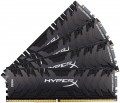Memory capacity
The total volume of all modules of the RAM kit.
Knowing this parameter and the number of planks in the set, you can estimate the volume of one plank. This information can be useful for assessing compatibility with a specific PC: any motherboard has a limit on the maximum volume of each individual bar.
Now on the market there are kits with such a volume of memory:
4 GB,
8 GB,
16 GB,
24 GB,
32 GB,
64 GB and even
128 GB. The combination of several sticks allows you to sell sets of
8 GB (2 sticks of 4 GB),
16 GB (2 sticks of 8 GB),
16 GB (4 sticks of 4 GB),
32 GB (2 sticks of 16 GB),
32 GB (4 8 GB sticks),
48 GB (2 24 GB sticks). 64 GB kits are represented by the following sets:
64 GB (2 sticks of 32 GB),
64 GB (4 sticks of 16 GB) and
64 GB (8 sticks of 8 GB). 128 GB RAM mainly consists of
4 sticks of 32 GB or
8 sticks of 16 GB. And
256 GB and
96 GB (2 sticks of 48 GB each) are not so popular
Memory modules
The number of individual modules included in RAM kit. One module occupies one slot on the motherboard, so to install the entire kit, the number of free slots must be equal to or greater than the number of modules.
If there is an even number of modules in the set, they can be paired. This mode significantly increases the speed, but is not supported by all models of motherboards, so in each case this point should be clarified separately.
Now on the market? there are modules supplied in such quantity:
one modules,
set of 2 modules,
set of 4 modules,
set of 8 modules.
Memory speed
The clock frequency of the RAM module.
The higher this indicator, the faster the “RAM” works, other things being equal, the higher its efficiency in games and other resource-intensive applications. On the other hand, a high clock frequency has a corresponding effect on the cost. In addition, in order to use the full capabilities of the memory, the motherboard to which the module is connected must support the appropriate frequency.
The most popular are modules with a frequency of
3200 and
3600 MHz - so to speak, universal workhorses. There are also more modest options - for example
2400,
2666,
2800,
2933,
3000 MHz. And advanced for serious tasks -
3866,
4000,
4800,
5200,
5600 MHz. High-frequency modules
6000,
6400,
6600,
6800,
7000,
7200 MHz and more are also provided.
Clock speed
The amount of information that a memory module can receive or transmit in one second. The speed of the memory and, accordingly, the price of it directly depend on the bandwidth. At the same time, this is a rather specific parameter, which is relevant mainly for high-performance systems — gaming and workstations, servers, etc. If the RAM module is bought for a regular home or office system, you can not pay much attention to bandwidth.
CAS latency
This term refers to the time (more precisely, the number of memory cycles) that passes from the processor's request to read data to granting access to the first of the cells containing the selected data. CAS latency is one of the timings (for more details, see the "Memory Timings Scheme" section, where this parameter is designated as CL) — which means that it affects performance: the lower the CAS, the faster this memory module works. However this is true only for the same clock frequency (for more details, see ibid.).
Now there are memory modules on the market with the following CAS latency values:
9,
10,
11,
12,
13,
14,
15,
16,
17,
18,
19,
20,
21,
22,
24,
30,
32,
36,
38,
40,
42,
46.
Memory timing
Timing is a term that refers to the time it takes to complete an operation. To understand the timing scheme, you need to know that structurally RAM consists of banks (from 2 to 8 per module), each of which, in turn, has rows and columns, like a table; when accessing memory, the bank is selected first, then the row, then the column. The timing scheme shows the time during which the four main operations are performed when working with RAM, and is usually written in four digits in the format CL-Trcd-Trp-Tras, where
CL is the minimum delay between receiving a command to read data and the start of their transfer;
Trcd — the minimum time between the selection of a row and the selection of a column in it;
Trp is the minimum time to close a row, that is, the delay between the signal and the actual closing. Only one bank line can be opened at a time; Before opening the next line, you must close the previous one.
Tras — the minimum time the row is active, in other words, the shortest time after which the row can be commanded to close after it has been opened.
Time in the timing scheme is measured in cycles, so the actual memory performance depends not only on the timing scheme, but also on the clock frequency. For example, 1600 MHz 8-8-8-24 memory will run at the same speed as 800 MHz 4-4-4-12 memory—in either case timings, if expressed in nanoseconds, will be 5-5-5-15.
Voltage
The nominal voltage required for the operation of the memory module. When choosing memory, you must pay attention to the fact that the appropriate voltage is supported by the motherboard.

